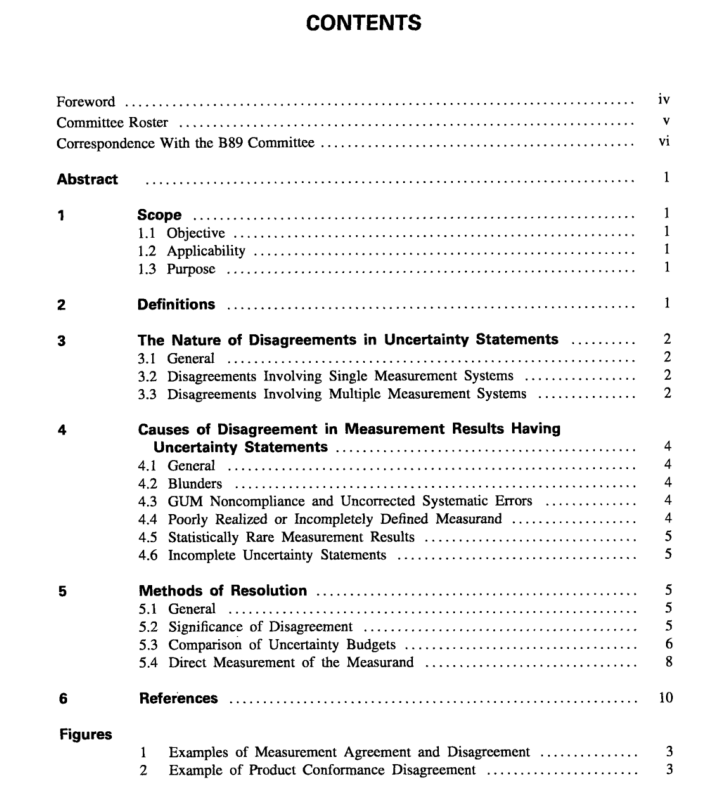ASME B89.7.3.3 pdf download

ASME B89.7.3.3 pdf download ~ U l DEl l ~ ES FOR ASSESSING THE REllABlllTY OF DlMENSlO~Al MEASUREME~T U~~ERTAI N ST~TEME~
1 SCOPE 1.1 Objective This technical report provides guidance in assessing the reliability of a statement of measurement uncertainty in question, that is, in judging whether that stated uncertainty can be trusted to include the values that could reasonably be attributed to the measured quantity (measurand) with which that stated uncertainty is asso- ciated.
1.2 Applicability This report is most applicable to statements of uncer- tainty in the results of dimensional measurements based upon the IS0 Guide to Expression of Uncertainty in Measurement (GUM). (Also called ANSVNCSL 2540-2.)
1.3 Purpose This technical report helps parties to avoid potential, or resolve actual, disagreements over the magnitude of a stated measurement uncertainty, particularly when that uncertaínty is part of a determination of conformity of a manufactured product to a dimensional specifi- cation.
2 DEFINITIONSI acceptance zone: the set of values of a characteristic, for a specified measurement process and decision rule, that results in product acceptance when a measurement result is within this zone.’
decision rule: a documented rule, meeting the require- ments of section 3 of ASME B89.7.3.1, that describes how measurement uncertainty will be allocated with regard to accepting or rejecting a product according to its specification and the result of a measurement. expanded uncertainty: quantity defining an interval about the result of a measurement that may be expected to encompass a large fraction of the distribution of values that could reasonably be attributed to the measur- and. See GUM, 2.3.5.
guard band: the magnitude of the offset from the specification limit to the acceptance or rejection zone boundasr.% 4, 5, 6, 7, 8
measurand: particular quantity subject to measurement. See VIM 2.6.
3 THE NATURE OF DISAGREEMENTS IN UN CERTA1 NTY STATEMENTS
3.1 General in an ideal situation, customers and suppliers will address the issue of measurement uncertainty when they discuss the product specifications. Agreeing on the measurement plan, the corresponding magnitude of the measurement uncertainty, and the decision rule (if applicable), will avoid future disagreements regarding the acceptance/rejection of a product. However, it is recognized that two experts can produce two different uncertainty statements often varying as much as 25% due to differing assumptions and data (as described in section 5). Resolving these differences at the contract stage is potentially less contentious than doing so after an argument develops over the acceptance or rejection of the product.
3.2 Disagreements Involving Single Measurement Systems in many situations there is only a single measurement system; e.g., a customer agrees to accept the supplier’s measurement results provided that the supplier uses stringent acceptance with a 100% guard band (i.e., the guard band equals the expanded uncertainty). In this example, a disagreement may arise if the customer feels the supplier has underestimated the measurement uncertainty. Although there is a single measurement system, the supplier and the customer have developed differing Uncertainty statements.
3.3 Disagreements involving Multiple Measurement Systems in some situations, a customer and supplier both make measurements, each having their own measure- ment system and uncertainty statement. There are two cases to consider: first, when a product characteristic is being measured to assign it a value, e.g., the length of a gauge block, and second, when a product character- istic is being measured to determine whether it conforms with specifications. Ln the fist case, a best estimate of the value of the product characteristic is being sought. Two measure- ments, from different measurement systems, will give a better estimate when their results are appropriately combined than will each system independently, provided the uncertainty statements associated with the measure- ment systems are valid. It is unlikely that the measure- ments performed by the supplier and the customer.ASME B89.7.3.3 pdf download









